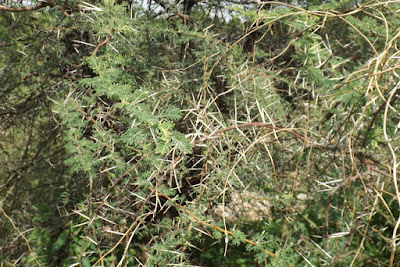If I had made
any New Year's resolutions (I didn't) I might well have resolved to post to
this blog on a regular basis and I would already be close to breaking my
resolution. That's entirely normal of course but... I would have an excuse (and
a real one at that!) For some time after we got back from our Christmas break,
we were without a reliable internet connection. Eventually we discovered that
the problem was not some arcane bit of IT or satellite programming that had
gone wrong but something we could solve fairly easily - the mounting for the
satellite dish was coming away from the wall and putting the dish out of
alignment. I fixed it back up and it seems to be OK now, so here goes......
Mandavu Dam.
Fourteen
kilometers from Sinamatella is the biggest body of open water in Hwange
National Park - Mandavu Dam. It's a hugely productive dam, thanks to the
nutrients introduced by the hippos and the hundreds of buffalo, elephants and
others that drink there in the dry season so it is popular with anglers who are
allowed to fish there at weekends. It's also a vital part of Sinamatella's game
water supplies, and an important breeding and feeding place for numerous birds.
We pass the dam
regularly and often spend time there counting and listing birds but until
recently we had never given a thought to the maintenance of the actual dam wall.
I'm certain we wouldn't have thought of it now if Colin Gillies from Wildlife
and Environment Zimbabwe hadn't e-mailed me with some concerns over the state
of the wall. I knew about as much about dam wall maintenance as I do about
computers (i.e. next to nothing) so I asked my good friend Professor Google for
help. He, of course, knows more or less everything, and as I read through
various websites that he suggested, I became more and more concerned.
The first thing I
was sure we needed to worry about was trees. Apparently, trees on an earth dam
are a disaster waiting to happen. Mandavu didn't have trees - it had a
forest........
The road across the wall - dam to the left,
forest to the right!
Next concern was
termites and animal burrows. We have both of those all over Sinamatella so
probably at Mandavu too but had anyone ever checked? Almost certainly not.
Prof Google guided
me to one website that gave a series of stages to look for to show any
deterioration in a dam wall. First stage, in which there is nothing to worry
about, is a flow of clear water on the
downstream side and the final stage, probably best labelled 'panic', is a whirlpool in the dam itself and a strong
flow of muddy water and debris downstream. As far as I could see, at that stage
all you can do is 1. Run for your life and 2. Call the emergency services. I
was pretty sure that we were far from that situation but not at all sure of
anything else so Courage Mutema, the Sinamatella Parks Ecologist and myself
went out to have a look.
It was, as you
would expect, a mixture of good news and bad news. The good news was that there
was a small flow of clear water through the wall, there were no active termite
nests (though there were some large ant nests) and no obvious animal burrows.
The bad news items were that the wall was covered in trees, that many of the
rocks which are meant to resist wave action (the technical term seems to be
rip-rap) were out of place and that the road across the wall has eroded,
causing rain water to pour down the back face of the wall where it has cut some
fairly disturbing gullies.
Part
of one of the gullies - not something you want to see in a dam wall!
The gullies were
obviously something we should be dealing with very soon so we started work on
them first. A proper solution to the problem will mean rebuilding the top of
the wall to direct rainwater into the rip-rap but that will take some
organising. For now, we have simply thrown tons of rock and brush into the
deepest gullies and we'll try to cover them over with soil so that grass can
grow and bind it all together. It would have been nice to have heavy
earthmoving equipment to do this but that's way beyond our resources. Instead,
we have manpower, and of course a Land Rover ....
Removing the
trees turned out to be a huge task. If they had been Mopane, as they would have
been in most parts of Sinamatella, it would have been difficult enough but in
fact they were mostly Acacia tortilis, which comes armed with both hooked and
straight thorns..........
..........and
strongly objects to being handled. It took us two full days to fell all the
trees, cut them into reasonably sized pieces, winch them up to the top of the
wall and stack them. By the end we were all heavily scratched and thoroughly
fed up with the task but satisfied to have got it done. I will go and kill all
the tree stumps with a strong alkali to stop re-growth and poison the ants
whose nests seem to go deep into the wall. We will eventually re-build the
eroded crest of the wall and spread the branches over it to protect the loose
soil and encourage grass-growth. All being well, this is a lesson learnt and
regular dam maintenance will become part of the annual work schedule at
Sinamatella. We are grateful to Colin Gillies for pointing out what needed to
be done - but I have to say, there were times as I pulled yet more hooked
thorns out of my skin, when I wasn't quite so grateful!






No comments:
Post a Comment